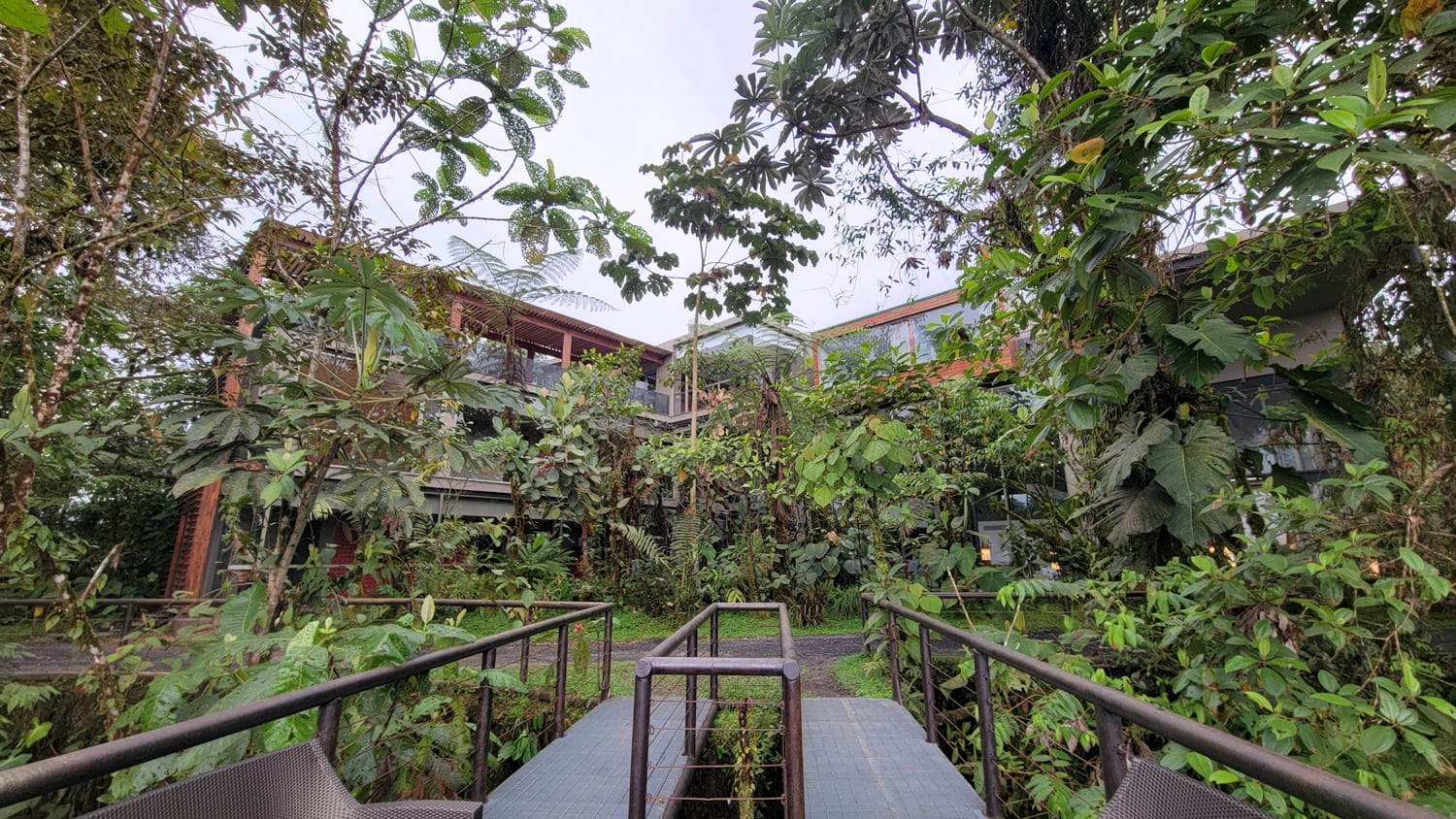
Trees towered above our vehicle in layers upon layers of green, birds swooped around us, and big drops of water fell down on our windshield with a heavy splash. As if someone snapped their fingers…just like that…I was in the middle of a rainforest. Just moments before we were driving through wide-open farm land; it’s as if we had crossed some magic line and things changed in an instant. Little did I know, but this was the start of my eco education. I sat in awe as we descended into a cloud towards the famous Mashpi Lodge and Reserve.
There was a magic line – the boundary of the reserve. One side of the line represented the natural state of mother nature if left to her own devices. And the other was side was what effect humans have when just trying to survive.
Before Mashpi became a protected area, the logging companies were busy cutting down all of these trees. In addition, the locals cleared the land for farming; it was the main source of business and opportunity in this area. However, a forward-thinking group of people purchased the land from the logging company with the goal to preserve this unique rainforest and cloudforest. Their plan was to not just save this special area, but to provide new jobs in the reserve for locals; giving them a new career path that was lucrative and made them ‘keepers’ of forest. If the locals looked at the area differently, with preservation as a way to make a good living, then real change would happen. And it did.
-
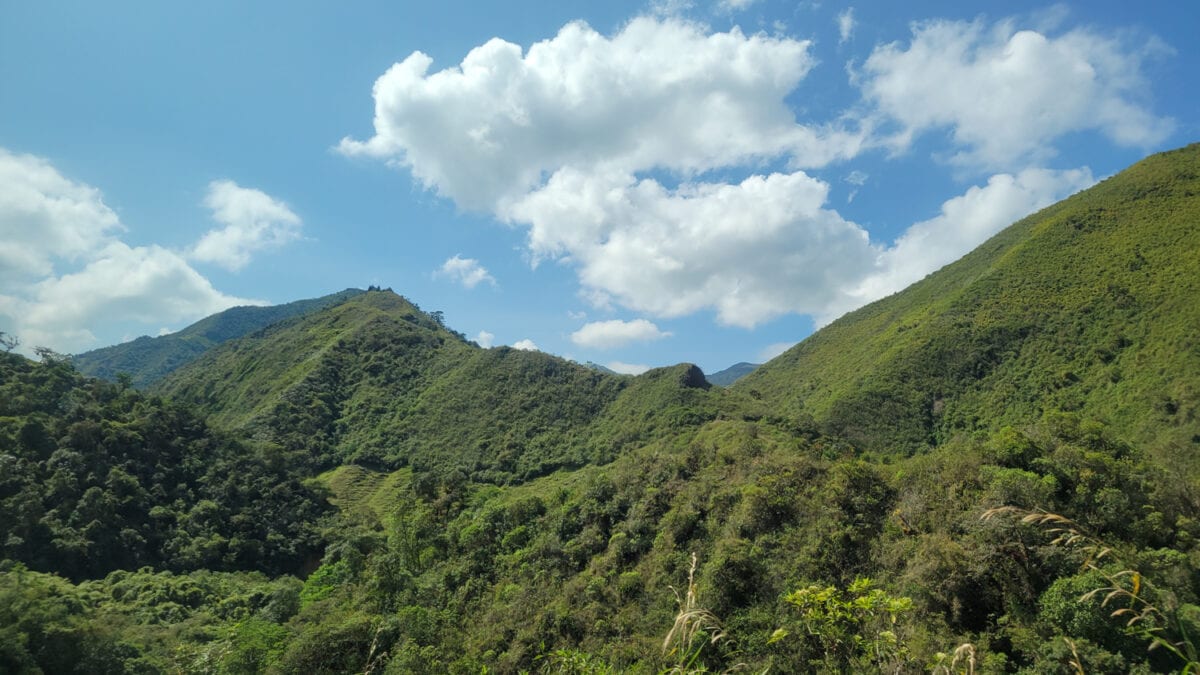
Before the Cloudforest -
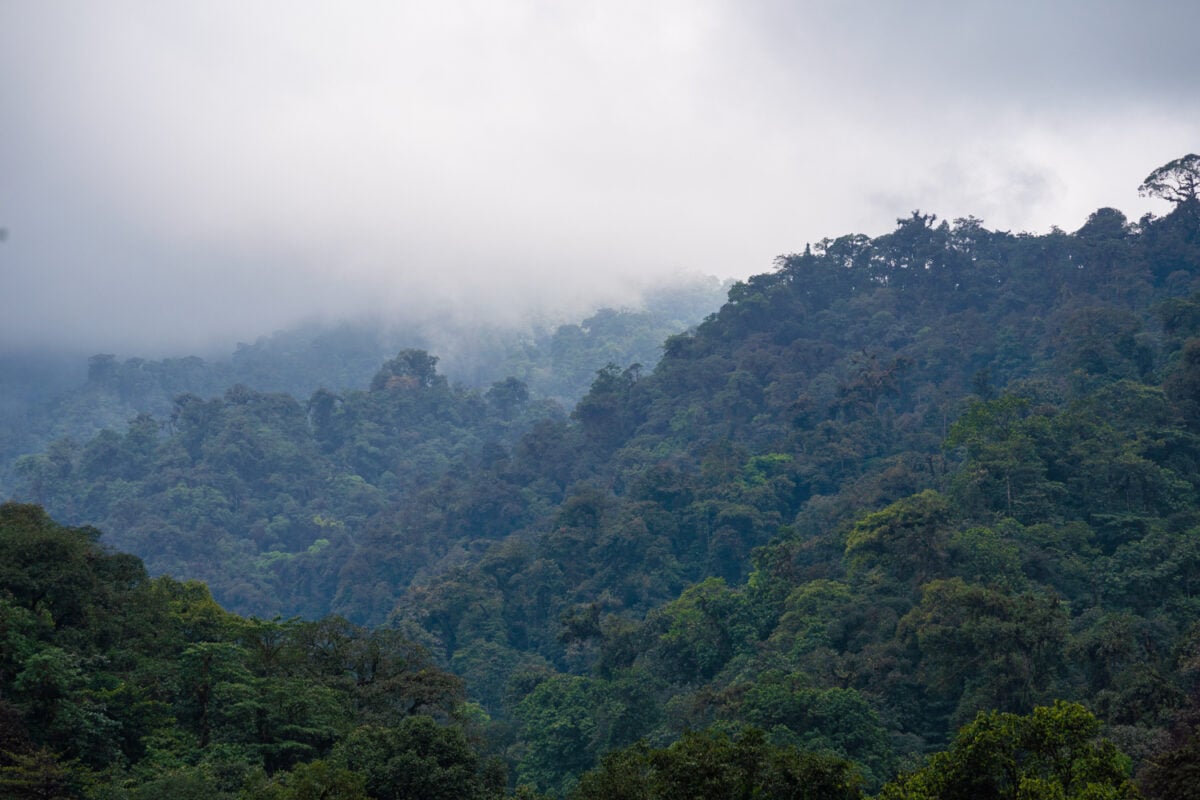
We Crossed the line…into the clouds
TABLE OF CONTENTS
Welcome to Mashpi Lodge and Reserve
Things to do at Mashpi Reserve
Mashpi Naturalist Guides
Get Involved with Citizen Science and Research
How to Visit Mashpi Reserve and Common Questions
How many days should you stay?
When is the best time to visit Mashpi?
What should you pack?
What photography gear should you bring?
How to get to Mashpi?
What are the Mashpi Lodge rates?
Welcome to Mashpi Lodge and Reserve
The journey to this new world was only 3 hours from Quito, but the last 5k was on a single lane muddy ‘road’ riddled with pot holes and so many S curves it felt like you were on a slippery roller coaster. The van wobbled about jostling us from side to side as we descended deeper into the clouds.
You have to really want to come here to make the journey to Mashpi.
But in my experience – if a place is hard to get to – it means it’s a very special destination.
Located in the northwest of Quito’s Metropolitan District, within the Chocó Andino Biosphere Reserve that stretches throughout South America, the Mashpi Reserve is a 2,500-acre private reserve. It is both a rainforest and a cloudforest (a rainforest that sits at a higher elevation). The reserve is home to over 400 species of birds, 43 species of amphibians, and 65 species of reptiles many of which cannot be found anywhere else in the world.
It is a vital hub for research and education with a dose of hospitality and tourism thrown in.
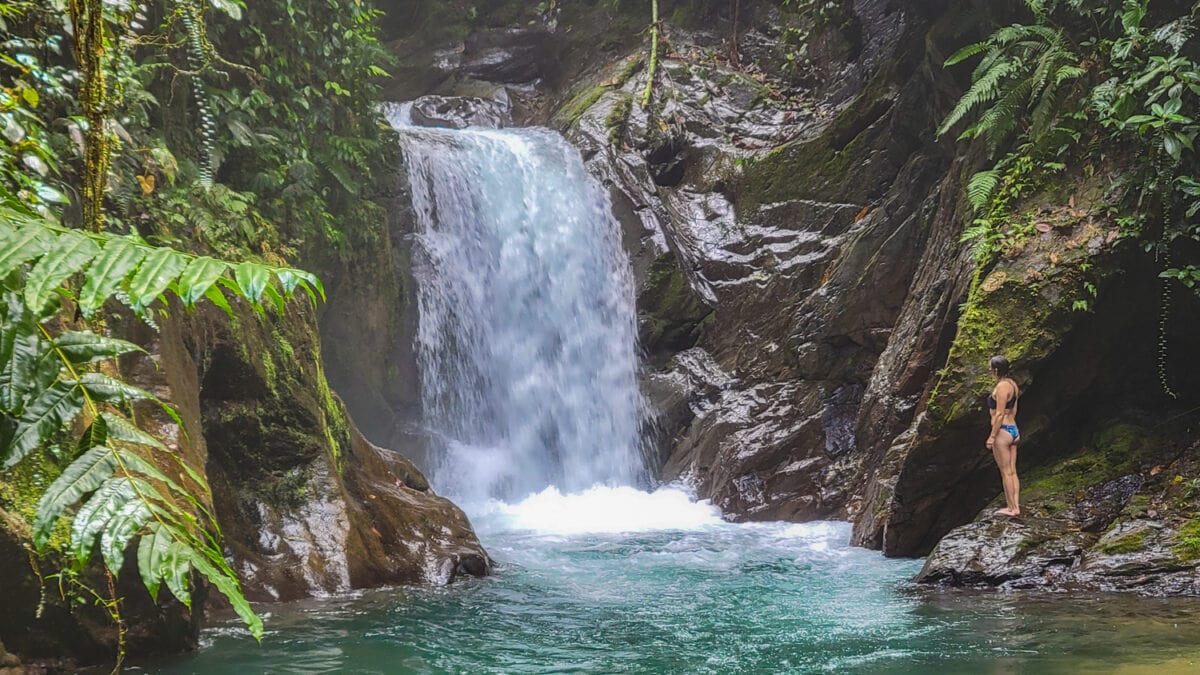
Other Hard To Get To Destinations That Are Worth It!
Canadian Arctic Inuvik
Wrangel Island Far East Russia
Subantarctic Islands in New Zealand
Wrangel St. Elias and McCarthy Alaska
Mashpi Lodge
Most visitors make the journey to Mashpi for the Lodge itself; it’s the crown jewel of the reserve.
Sitting at over 3000 ft. the lodge feels perfectly in sync with its surroundings. I had one of those rare moments where you walk in the front door of the building and immediately let out a little gasp of awe as I stared into the dining area with floor-to-ceiling windows over 3 stories high. On the other side of that glass were trees. So. Many. Trees. The lodge was cradled among tree of all sizes, it felt like a blanket of green keeping you cozy and safe.
The Lodge is located on the site where the timber company’s sawmill stood which allowed the build to have very little new environmental impact. The reserve land was bought for conservation, not tourism. I had the opportunity to meet Roque Sevilla, former Mayor of Quito, entrepreneur, and Chairman of the Board of Metropolitan Touring, an environmentally and socially responsible travel company that owns Mashpi Lodge. He believes that helping local communities feel responsible for conservation is crucial. The goal was to have everyone in the area feel that they are a part of the project, that they own it, and take pride in it.
On the tourism side, he said “We only build hotels in iconic locations. We don’t build them for profit.” Tourism helps achieve his community and conservation goals. Making tourists happy generates money for local communities and services, directly and indirectly. In my opinion, this is truly one of those experiences where tourism is doing good in the world.
With only 19 rooms and 3 suites, it’s an intimate travel experience. The all-inclusive stay includes your meals and non-alcoholic drinks, as well as a nature guide that will lead your party through the various excursions (also included) in the rainforest as well as educate you on the flora, fauna, and local culture.
Mashpi Rooms
I walked into my room which was surprisingly dark, but it was set up for the best ‘reveal’ I’ve ever had in a hotel. There was a remote at the entry for the curtains in the room. I pointed it at the dark red curtain and hit the ‘up’ button. The floor to ceiling curtain started to rise. Light poured into the room like a waterfall. As the curtain slowly raised, it revealed a wall of green trees with light dancing through the branches and leaves. The entire back wall was made of glass. I walked up to the giant window, said hello to Mother Nature, and whispered, “I love you.”
Like a curtain going up on a Broadway show, I knew I was going to see something special for the next two days.
Next to the remote was a simple card that read like a playbill:
Escape the city
Flee the noise
Find Your tranquility
Acquaint yourself
Learn
Discover
Reconquer
Welcome
Get a New Perspective of the Rainforest
Normally you only get to see a small percentage of what is happening in a rainforest – whatever is close to the ground. Mashpi offers plenty of those types of hiking excursions. But as we all know – the canopy of trees tower hundreds of feet in the air creating completely different ecosystems as you ascend through the canopy. Mashpi has done what I thought to be impossible – they take you up in the canopy to get a full perspective on the forest with their one-of-a-kind experiences.
Things to Do at Mashpi Reserve
Dragon Fly Gondola
Ever wonder what it’s like to be a drone? Wonder no more – the Dragon Fly gondola is the latest project at Mashpi. It took 5 years to complete, but it’s really the jewel of the Mashpi excursions. This open-air cable car system (gondola) carries you over, across and sometimes even directly through the forest canopy at heights of 200 ft above the forest floor.
The Dragonfly was designed to minimize impact upon the natural setting; constructed largely by hand to avoid bringing heavy machinery into the fragile forest environment. Powered by renewable energy, the gondola is designed to blend seamlessly and silently into the forest. Take one look at the tall towers that house the cables and you can’t help but be in awe of the fact that all of this heavy equipment was hiked in.
Our little gondola seated 4 plus our guide. It lifted us high above the trees for incredible views and a perspective few people get to see. The ‘ride’ goes at a snail’s pace so that you have plenty of time to look around and take pictures. Plus, the guide does have the ability to stop the cable at any point to get a better look at something.
My favorite part was the sounds of waterfalls and streams cutting through the silence high up in the trees.
Sky Bike Through the Rainforest
If you want more control over your canopy perspective then you’ll want to hop on the inventive sky bike where you control the speed – and even the direction (there is only forward and reverse).
You can peddle your way through the canopy for a short distance allowing you to once again to get the unique view above the canopy. This is under your own power – so it’s not a cake walk, but it’s also not too hard. While we were sky-biking through the trees we spotted a sloth!
Rainforest Hiking
Oh be still my heart…hiking on the rainforest floor is absolutely incredible. Nothing makes me feel closer to nature than getting my boots muddy (and there’s plenty of that) while hiking through towering trees and rivers. And just when you are so hot and sweaty that you can’t stand it any longer, you end at a waterfall to take a swim. Perfect. Hiking. Day.
Many of the hikes require a lot of up and down on narrow trails and steps made of recycled plastic crates. You will also find yourself hiking through streams for long periods and in really muddy areas.
Mashpi supplies welly boots, a backpack, binoculars, rain ponchos for downpours (Mashpi gets 230 inches of rain a year), water bottles, bug repellent, and a hiking stick. My favorite part of the hiking at Mashpi was hiking in the rivers – as sometimes that’s the easiest path to take in the rainforest. As we hiked our guide, Nestor, would point out various creepy crawlies sending my heart rate skyrocketing (I’m pretty sure he enjoyed watching me squirm!).
And of course, the waterfall swims were magical.
Night Wildlife Hikes
The best immersive experiences happen at night in the rainforest. We went out armed with flashlights and our guides for a night hike to see all of the creatures that come out when the sun goes down. I honestly didn’t know frogs could be that tiny…the size of your thumbnail. Nestor and Victor were experts at spotting things in the night – without them, I would’ve seen nothing.
We saw frogs, scorpions, spiders, and snakes…all the things of nightmares! However, these animals didn’t really care about us – they were just going about their nightly business. And after a couple of lovely cocktails back at the lodge that night – I slept like a baby…happy inside my glass walls!
Bird Watching
With over 400 species of birds (35 endemic species), Mashpi is a premier place to do bird watching and photography. Every morning they offer birdwatching right at the lodge. Go out on the back deck and have a guide point out the various birds as you sip your coffee.
In addition to the ‘morning show’, we also hiked to the Life Center one afternoon and watched as the various species of birds came to feed. The colors are so stunning, nothing like I’ve ever seen before. During our afternoon bird watching at the Life Center deck, we were treated to wine and snacks. Mashpi always throws in a little dash of luxury even though you are in a remote place.
In addition, Mashpi offers a special hummingbird viewing area. It is equipped with benches and multiple humming bird feeders. The forests of Mashpi boast 32 hummingbird species identified to date, inhabiting different specific altitudes, with around 19 species alone observable by guests in the garden. Be prepared to have some fun ‘fly-bys’ as the hummingbirds often buzz you!
Butterfly Garden
Also, at the Life Center you’ll find the Butterfly Garden. A guide will walk you through (and physically show you) all of the stages of a butterfly’s life. Then you can spend some time among the butterflies in the netted portion of the ‘garden’. Be ready to get a lot of butterfly attention as they love to land on you and hang out. It sort of makes you feel like you are a Disney princess with butterflies flitting around and encircling you.
Mashpi is Changing Lives for the Better
When you arrive, every group is assigned an expedition guide who helps you plans your excursions during your stay. This is your group’s guide for the entirety of your stay. All of the guides are local to the area and are full of knowledge. In fact, 75% of the staff at Mashpi are from local communities. Mashpi provides education and sources of employment and income as an alternative to logging or harvesting.
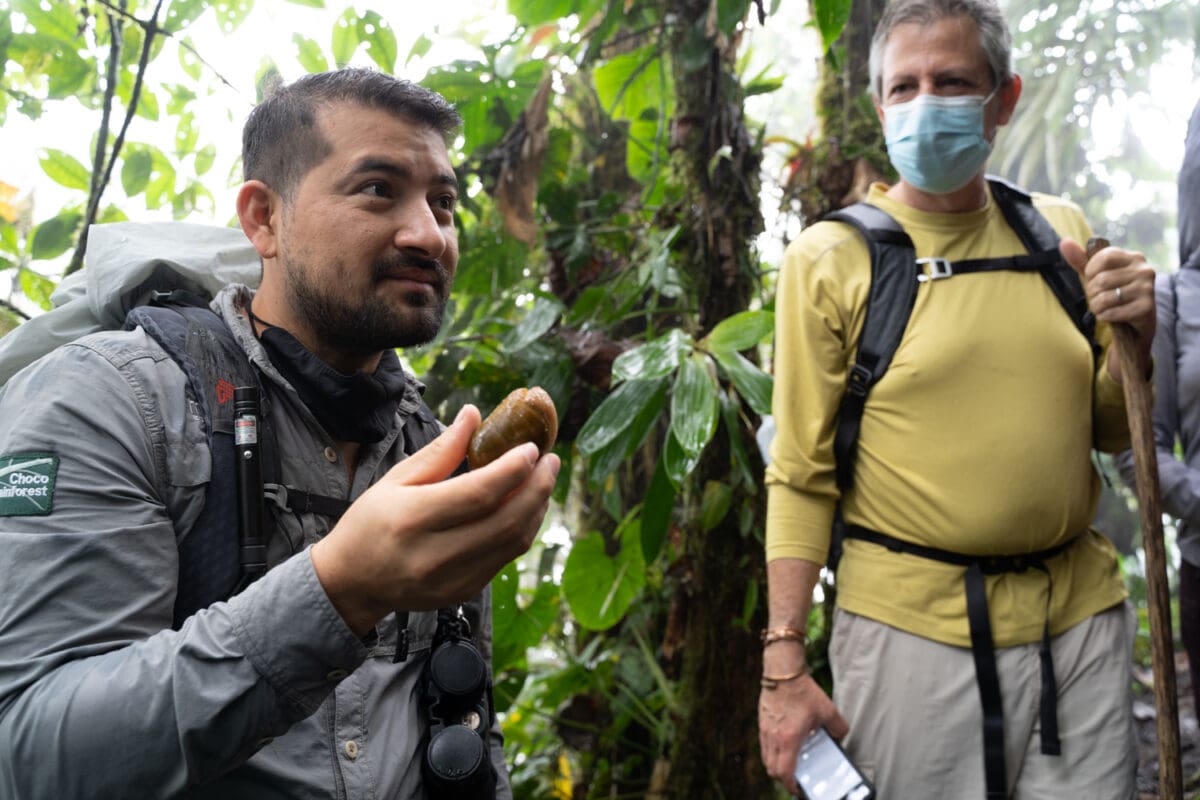
Our naturalist guide, Nestor, is a local who started working with Mashpi 8 ½ years ago and is a perfect example of Mashpi’s success. Since working there, he has become an absolute advocate of conservation and education, and he also learned English thanks to being a guide.
I asked him what he would have been doing now if Mashpi didn’t come into his life.
“I would have been a farmer of chili peppers and passion fruit. That’s what my parents taught me and it was a very easy job.”
His parents were farmers and brought home a meager income and he thought he would continue to do the same.
“I am happy, I learned about conservation, and now I have the chance to teach other people here and around the world about it. We (his family) used to destroy the forest by clearing trees for farming from 2000 to 2012, but now this forest is my best friend,” explained Nestor.
Nester went on to say that when he got the offer to work at Mashpi, he felt as if he were asked to play on a professional soccer team. When you are equating your job to being a professional soccer player in South America…you know it must be a dream job!
He started working as an assistant biologist, learning all about the forest, species, and conservation. He then moved on to be a support guide where he studied the other guides as they interacted with guests, and was able to start practicing his English skills. Then he became a naturalist guide where he really was able to work on his English skills as well as become an expert in the flora and fauna of the rainforest.
Get Involved in Citizen Science and Research
Since the goal of the reserve is to preserve, educate, and discover nature, there is also another component to Mashpi – research. They host visiting scientists doing various forms of research in the reserve. The lab’s purpose is to conduct scientific studies to fully understand the ecosystems within the reserve and gather as much information as possible about the plant and wildlife of the cloud and rain forests.
Mashpi has 15 camera traps throughout the reserve which allows them to monitor and study the movement of the wildlife. And they also give guests a chance to get involved with that learning and research.
Guests can visit the Mashpi Research Lab just steps away from the lodge. There they can meet scientists, learn about the various research projects, and see close-ups of insects that live in the rainforest. Beware – some are creepy.
I adore citizen science/volunteering – especially when I travel. It’s a way to further satiate my curiosity when I travel, be hands on, and do something good for the community I’m visiting.
Guardians of the Rainforest
While I was at the research lab, I was introduced to one of the coolest conservation and research projects I’ve ever encountered. The Guardians of the Rainforest project bings together scientists, conservationists, and citizens to protect something valuable from something potentially dangerous.
If you are anything like me, you have a few old cell phones laying around that you don’t know what to do with. Topher White, founder of Rainforest Connection developed a way to use old cellphones to listen and essentially stop deforestation of protected areas.
The cell phone is housed in a waterproof box called a ‘Guardian’ and powered by solar panels. The Guardians are automatic sound recorders. The box has built-in microphones that detect sounds (and ultrasounds) 365 days a year, 24 hours a day. The recordings are stored in an internal memory, while the cell phone signal transmits the information to the Rainforest Connection platform, which in turn monitors the sounds in real-time.
Special attention is paid to sounds, such as the whine of a chainsaw or the explosion of a shotgun, which indicate illegal activities. Using pattern matching technology, the software then sends an alarm to the Reserve’s park ranger team, so that they decide quickly to investigate what might be happening at that location.
In the beginning, when Mashpi started this project it really was to stop the threat of logging and other illegal activities within the reserve. It has been successful in deterring those activities so much so that they are on the decrease!
Mashpi is now starting to use the technology and software to recognize species in the forest. They have the sound of the howler monkey identified and can now track their whereabouts in the forest just by following their sounds. They are also doing this with five or six bird species.
The Guardians of the Rainforest project has gone beyond rainforest protection and into research.
I was so taken with this project. I loved to learn about the innovation and recycling of cell phones. It was just science goodness in every way possible! I was excited to hear Mashpi is talking about one day allowing guests to spend an afternoon in the lab helping identify sounds and adding that to the overall global Guardian database.
In the meantime, you can also just listen to the Mashpi Reserve Rainforest in real time with their app! Check it out – it’ll transport you to another world!
Download the Rainforest Connection app to listen to the Guardians of the Forest in Mashpi live:
Apple Store
Google Play Store
How to Visit Mashpi Lodge and Reserve & Common Questions
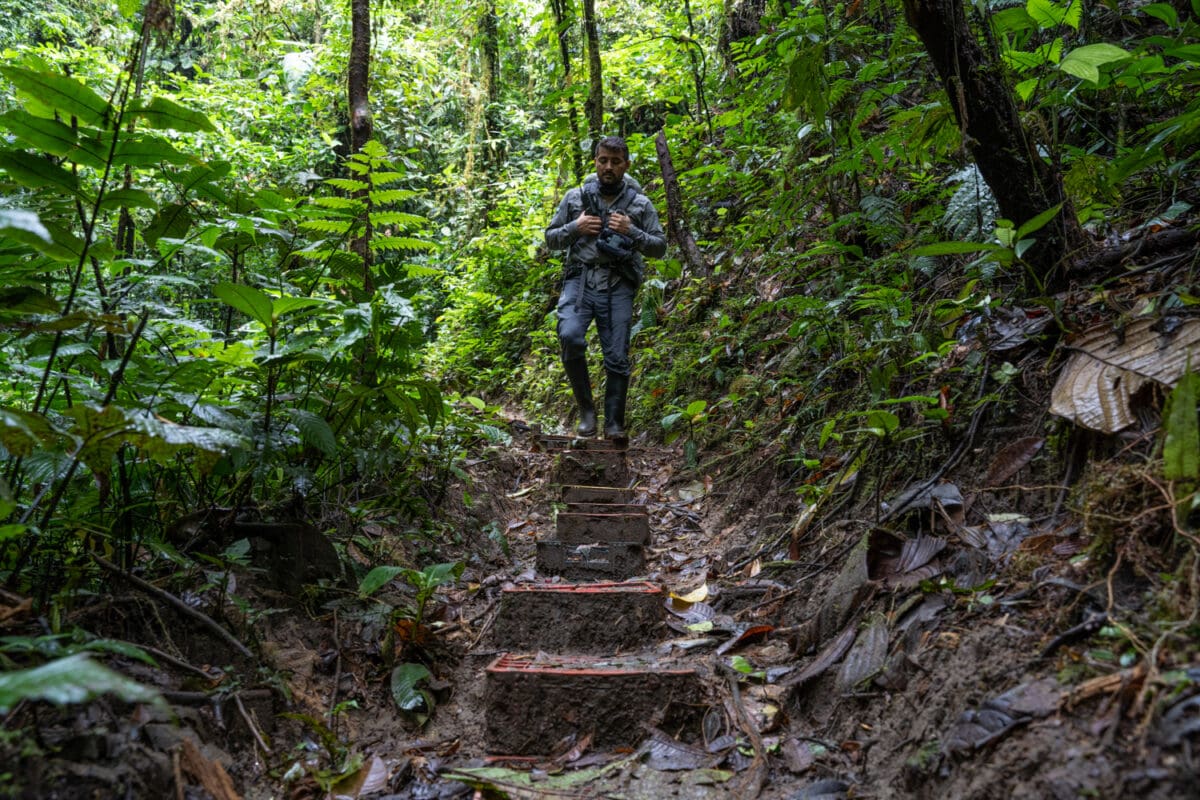
How many days should you stay at Mashpi Lodge?
We were there 2 days – and we were able to do a ton of the experiences and really get a feel for the forest and the conservation. However, if you can swing it – I suggest 3 days as it would provide you more time to get involved in research projects at the lab.
When is the best time to go?
Mashpi straddles the Equatorial line. This means that the weather remains pretty constant throughout the year. All of the activities are available year-round!
What to pack for the Rainforest?
Whatever you do, don’t forget your rain jacket and pants! I used my Prana Halle pants for hiking as they repel rain very well, they have lots of zippered pockets, and are stretchy and comfortable. If it would have started to downpour – our guides had heavy ponchos for us to use.
Marmot EVODry Torreys Jacket
Great for a wind and rain barrier as a top layer for your adventures. EVODry Torreys Jacket offers the weather protection you need for unpredictable days and the lightweight breathability you want in a high-performance shell. I always have it with me in my pack.
I earn a commission if you click this link and make a purchase, at no additional cost to you.
prAna Women’s Halle Roll-up, Water-Repellent Stretch Pants
Stretchy fabric is great for hiking and travel. Leg pocket is big enough for a phone. And the best part is that these pants can make the transition from hiking trail to nice restaurant easily – which means they are great for travel!
I earn a commission if you click this link and make a purchase, at no additional cost to you.
03/04/2022 08:50 am GMT
Wool socks –
Water shoes for waterfall swimming
Headlamp with red light for night hike
Also don’t forget a swimsuit, dry bags, and a waterproof case for your phone!
What do you need for wildlife photography at Mashpi?
Camera Gear
Mashpi is a birding photographer’s dream! If you want to try your hand at wildlife photography, here are a few important things to bring with you based on the kit (Sony) I use:
Sony a7 III Full-Frame Mirrorless Camera
Sony a7 III Full-Frame Mirrorless Interchangeable-Lens Camera Optical with 3-Inch LCD, Black
I earn a commission if you click this link and make a purchase, at no additional cost to you.
03/04/2022 12:59 am GMT
Telephoto Lens to capture those distant birds and wildlife.
LensCoat Raincoat and covers to keep your gear dry and protected in the wet environment.
LensCoat RainCoat Camera Rain/Snow Cover
Don’t let the weather stop your photography! This innovative cover provides protection for your camera and lens from the elements like rain, snow, salt spray, dirt, sand and dust while allowing you easy access to the camera and lens controls.
I earn a commission if you click this link and make a purchase, at no additional cost to you.
Tripod is really helpful for bird photography – especially for the hummingbird garden where you need a very steady hand and a long lens.
Peak Design Travel Tripod
A travel tripod that packs down to the diameter of a water bottle—without compromising height, stability, or features. Radically faster to setup and takedown, our tripod features ergonomic adjustment points, built-in mobile compatibility, and thoughtful details at every turn.
I earn a commission if you click this link and make a purchase, at no additional cost to you.
And don’t forget a good photography backpack to carry it all in. You can bring any type of camera bag, but for me one that is really designed for photography with extra padding and lots of space for multiple lenses and gear is best for this photography focused trip. Be sure it has a rain cover and a waist belt!
Lowepro LP37226-PWW Whistler Backpack 350 AW II
A true, all-season and versatile pack, the Whistler BP 450 AW delivers amazing performance for wilderness photographers and adventurers.
I earn a commission if you click this link and make a purchase, at no additional cost to you.
03/04/2022 08:51 am GMT
How to Get to Mashpi Reserve
Mashpi offers transport service in Quito from: the Marriott Hotel, the Swissotel, Casa Gangotena Boutique Hotel, and the Hilton Colon. It is a 3 ½ hour fascinating drive across the equator, through small villages, and mountainous farmland. You may want to have some Dramamine!
If you have your own car, getting to Mashpi Lodge on your own is also an entirely doable and even fun experience. However, given its rather isolated location on the outskirts of Quito, it requires careful preparation and planning in order to not get lost along the way.
It’s Easy to Get to Quito
JetBlue actually has budget friendly airfares direct from Fort Lauderdale to Quito starting at $130 one way. Then it’s easy to take a domestic flight from Quito to the Galapagos for not much more than it would cost you to just go to the Galapagos directly.
Mashpi Rates 2022
You are not simply booking an average night at an ordinary hotel. Rather, you are booking an Expedition Experience that’s focused on tailored and guided excursions throughout this incredible hotel in the rainforest, complete with visits to interactive sites and journeys.
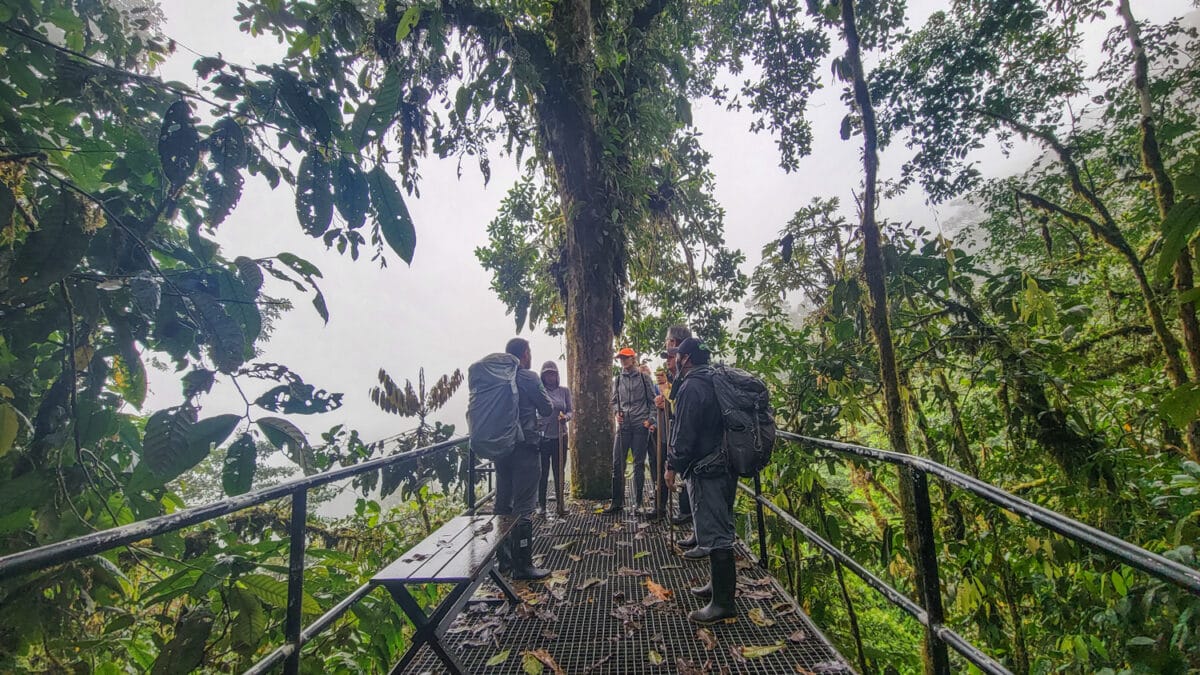
For 2022 nightly rates starts from $1,154 for a double occupancy room. Taxes and services charges are an additional 22%, and there is a Municipal Tax of US $2.75 charged per room, per night. There are special rates for solo travelers.
- Three meals a day and non-alcoholic drinks are included
- All excursions and a personal guide is included
Be sure to check out the Mashpi Special Offers Page. They often have really great deals for combining Quito, Galapagos, and Mashpi as well as other special rates. You can stay 2 nights in Quito at Casa Gangotena, 2 nights at Mashpi (all inclusive), and 3 nights in the Galapagos plus all transfers for around $5400 per person – experience the best of Ecuador!
Learn why you should include Quito on your trip to Ecuador
Staying at Mashpi is a unique, special experience. In fact, even though the main reason for my trip to Ecuador was to see the Galapagos Islands, Mashpi Rainforest ended up stealing the show for me. It was my favorite thing I did in Ecuador. And quite frankly – I didn’t want to leave.
It is a bit more of a luxury/expensive experience than what I normally do – but it was so incredibly worth it. By visiting Mashpi Lodge, you are directly contributing to the conservation and deeper understanding of this unique and precious ecosystem, as well as the local community. Most importantly you feel like you are making a difference, like you are a small part of something much bigger than you. It’s one of those moments where travel feels transformational – and that’s always worth it.
Related









